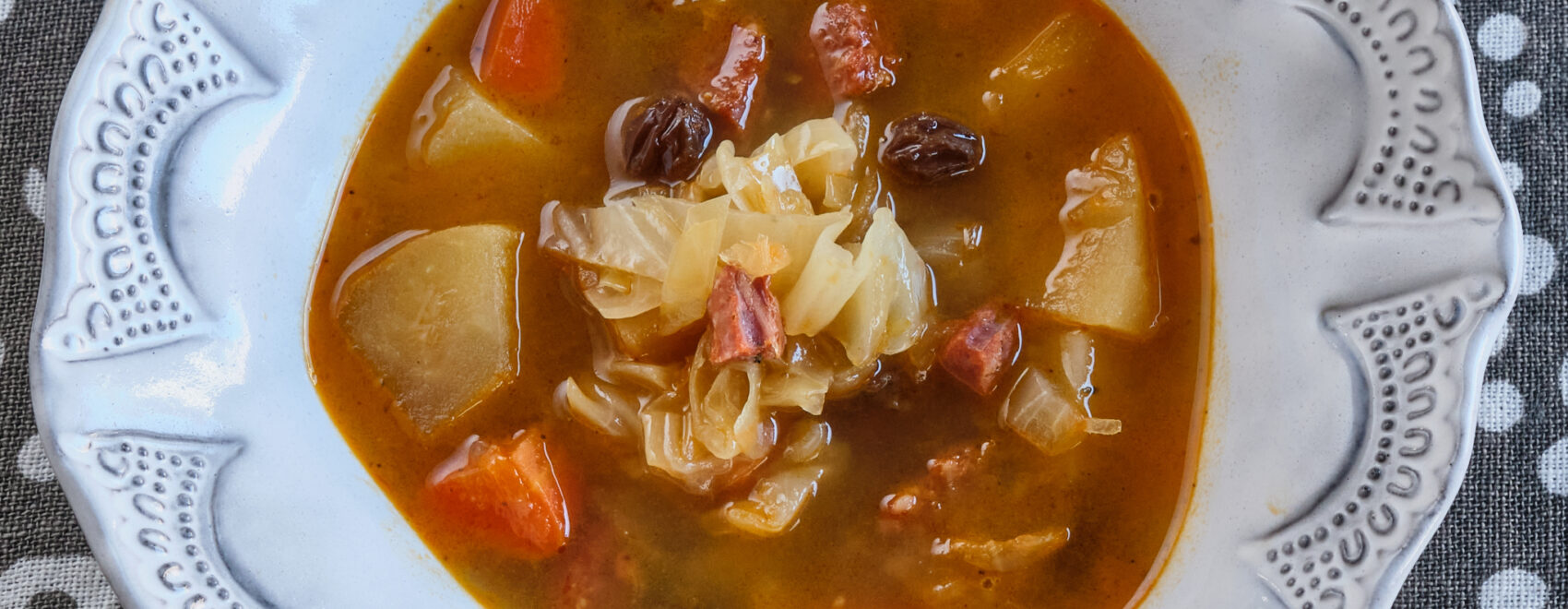Smoky, sweet, sour, tart, loaded with cabbage (fresh or fermented), this traditional soup is a hearty, delicious winter staple.
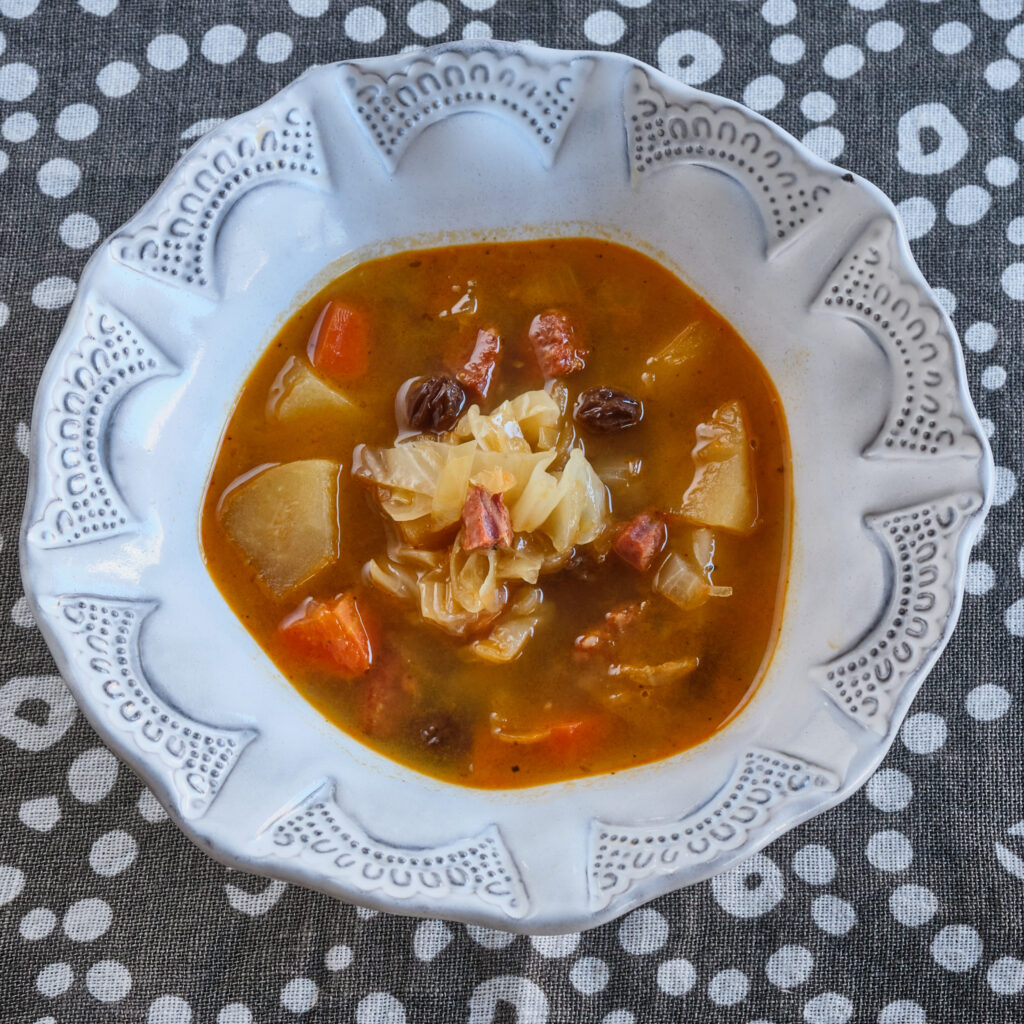
Sweet & Sour Cabbage Soup, with it’s lovely amber color and mildly spicy flavor is a staple at our house in the winter. It includes an array of zippy spices we always have on hand–cumin, oregano, paprika, and black pepper. And garlic, which by the way, you can’t use too much of–as long as it’s cooked.
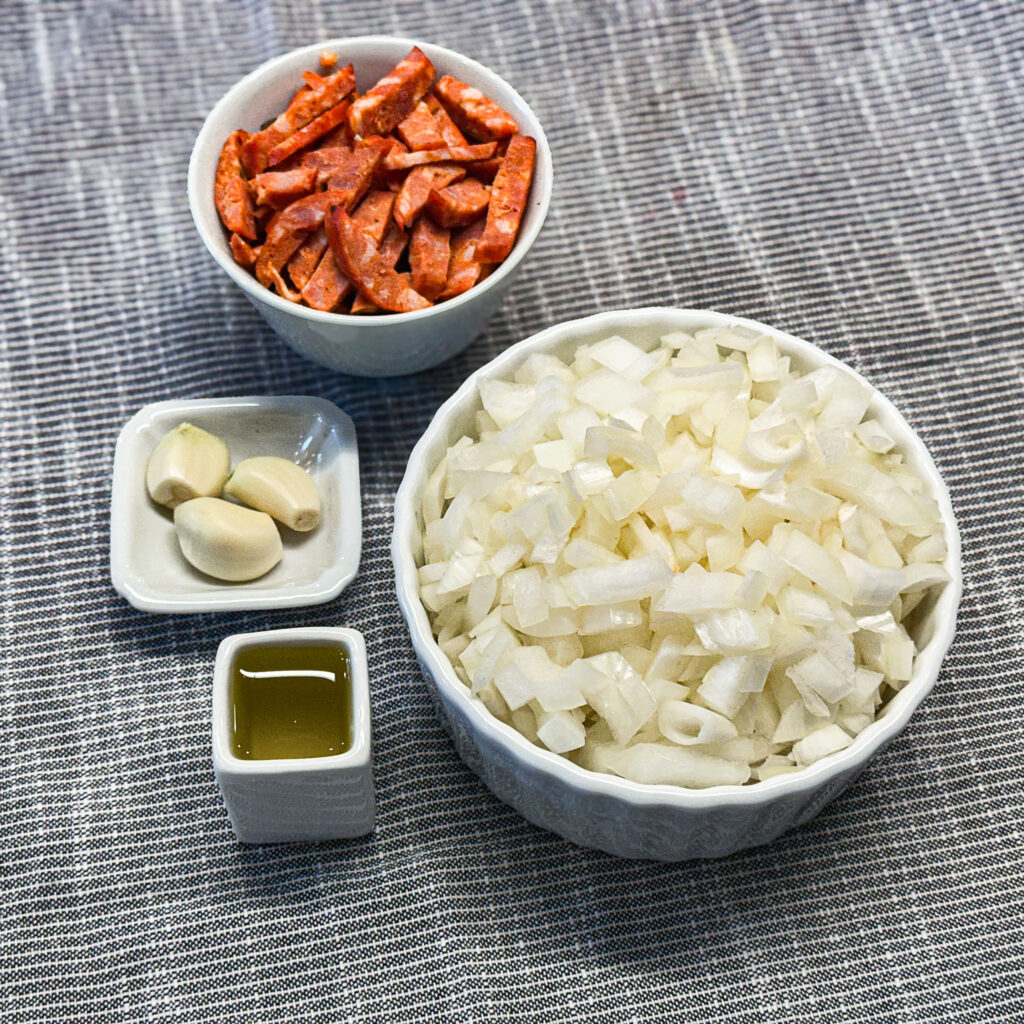
“I see recipes calling for one clove of garlic. One clove of garlic is not enough for any recipe unless it’s a recipe for, ‘how to cook one clove of garlic’ – even in this case use two.” …Author Unknown
Reduced apple cider vinegar together with brown sugar adds a distinctive sweet and sour note. And you can customize the soup by choosing your fave cured, smoked sausage (Portuguese Linguica (our fave), Spanish Chorizo, or French/Cajun Andouille), sweet or smoked paprika, and raisins or currants for an extra burst of flavor.
Note on Sausage Nomenclature: Cured refers to the process of preserving meat using salt and other ingredients to inhibit bacterial growth. Smoked refers to the process of exposing meat to wood smoke (of various types) to add a smoked flavor. Most ready to eat sausage is the result of both methods.
Women Who Kept Tradition & Their Families Alive
My German Hutterite grandmother, Mary Pullman Stahl, grew up in The Colony in South Dakota. Speaking only German, she left the colony with her husband Joseph Stahl and their six young children toward the end of the Great Depression. Subsequent years saw a steady stream of visiting Hutterite relatives at my grandparent’s home in Seattle, many of whom stayed for months or years.
Times were tough. My mother told me that when she was a child chickens lived in the house in the winter, as they were a main source of food. The six children, my mother, Virginia Francis Stahl, among them, struggled to learn English.
Gramma Mary, even well into her 90’s, didn’t eat dinner with the rest of the family. She stood and heaped plates with food. Only after everyone was fed did she sit alone in the kitchen and pick through the scraps. I watched her eat the remains of a chicken many times. There was nothing left but bone when she finished. So I wondered. And asked. She laughed. And said. “You’re too skinny, Susala.”
It seems remarkable to me today that I grew up, never hungry, always warmly dressed, knowing so little about my family history. And especially about this strong, resilient, inordinately generous woman whom I love so dearly.
Mary knew how to feed a family. To keep them alive. And one of her key tactics was a large barrel of heavily salted cabbage, otherwise known as sauerkraut, fermenting in the cellar. With it she made a German version of this soup weekly when I was a kid. A huge pot of it was always on the stove, ready to eat. I assume that my mother, aunts, and uncles grew up with it as well.
Many Eastern European countries–Bulgaria, Czech Republic, Hungary, Poland, Romania, Russia, and Slovakia, as well as the republics of Belarus, Moldova, and Ukraine–make a version of this soup. And depend mightily on it for sustenance.
For earlier generations, sauerkraut was a dependable, nutritious vegetable source during cold winter months. Today we’re more likely to encounter it as an optional hot dog condiment or as an integral part of a sandwich, such as my fave, The Reuben.
So when I first ran into recipes for this sweet and sour soup, I was intrigued. It’s called Kapusnyak. And it’s made in numerous styles, most, but not all, of which rely on the distinctive sour flavor of sauerkraut. The soup can be made with or without meat (usually pork). There are also versions that include tomatoes.
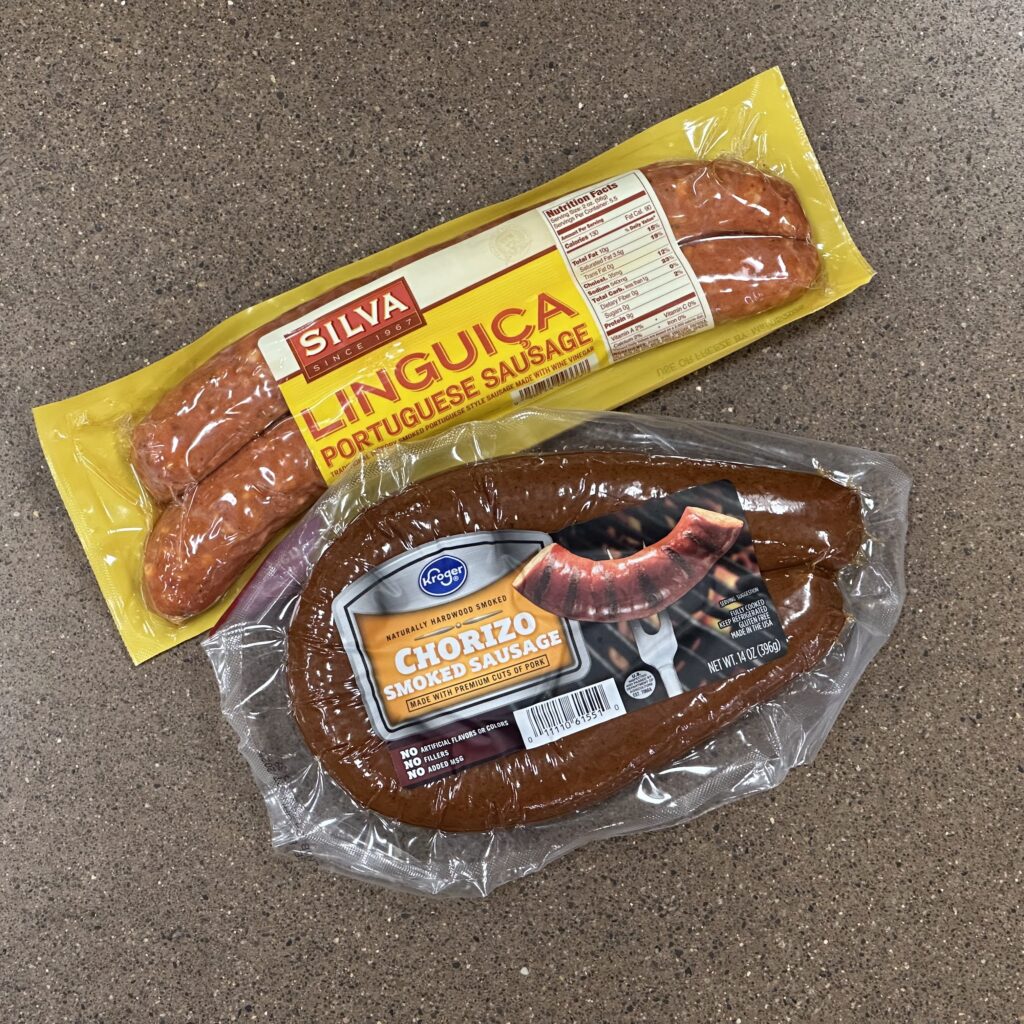
For this version I didn’t stray too far from tradition, although I decided it might be too great a leap for my brood to include sauerkraut, which apparently only I love. So I bought a large head of fresh cabbage and experimented with several different smoked pork sausages, finally settling on Portuguese Linguica. It’s a fully cooked sausage made with pork butt, which gives it a lean, meaty taste. I love the garlicky, mildly spicy flavor and array of spices (oregano, paprika, garlic, pepper, cumin). The bonus is that it gives this soup a lovely amber hue.
In A Pinch: If you happen to have loose pork sausage on hand, you can mix it with minced garlic and smoked paprika, and use in place of smoked sausage. No, it won’t be quite the same, but it will be delicious nonetheless.
Raisins were a last-minute hunch, and they work beautifully. In fact, my Main Man said “Add MORE next time.” You’re given a choice here between raisins and currants. They both work. (I prefer currants.)
TIP When cooking with vinegar, in most cases, you’ll want to soften its acid by reducing it before adding it to the recipe. That’s what we do here by reducing vinegar by half before combining it with brown sugar to create the sweet-and-sour aspect of this soup.
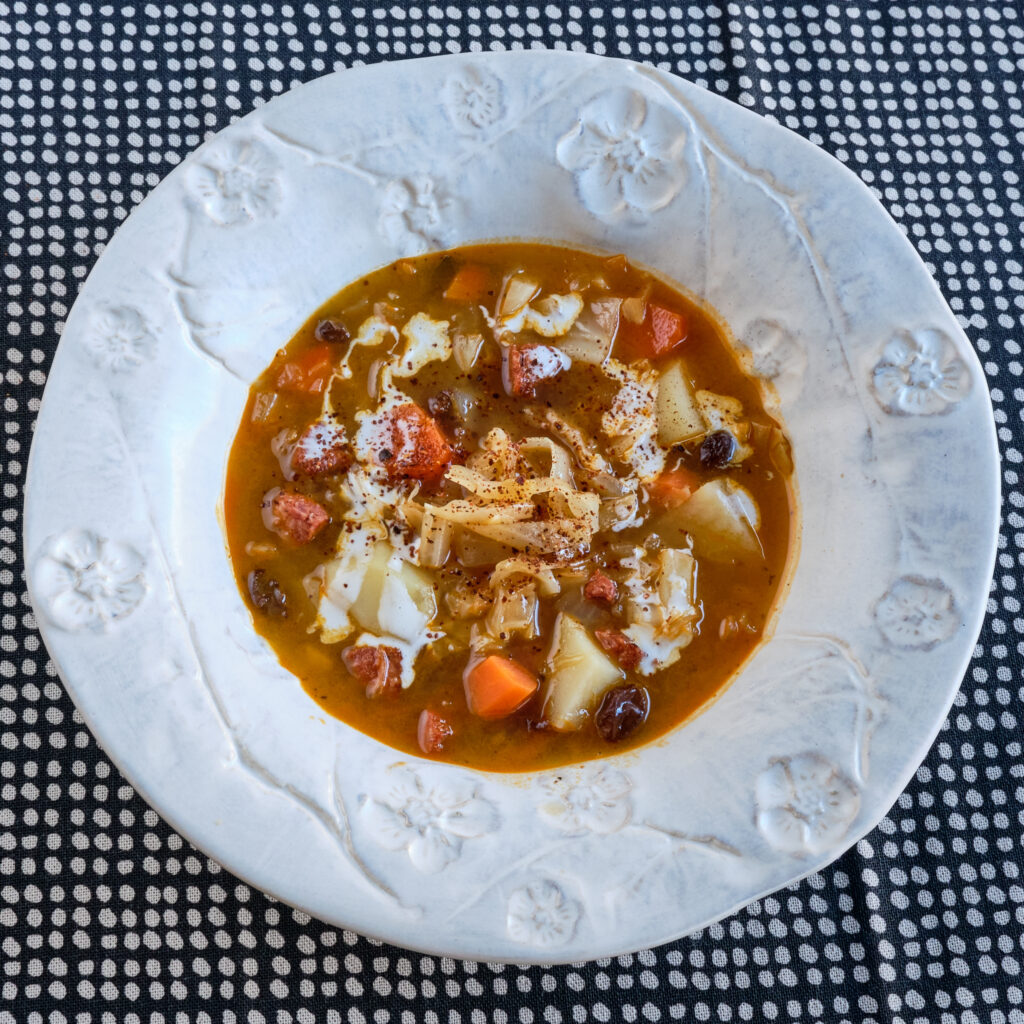
Sauerkraut Soup Q & A
Which countries make a version of sauerkraut soup?
Wow! What a question. Perhaps I should have asked which countries DO NOT create a version of cabbage or sauerkraut soup. Here’s a short list of those that do, along with the name they use:
- Czechia: Zelňačka or Zelná Polévka
- France: Soupe Aux Choux
- Finland: Kaalikeitto
- Germany: Kohlsuppe or Krautsuppe
- Poland: Kapusniak
- Russia: Sour Shchi
- Sweden: Kålsoppa
- Ukraine: Kapusniak (often called Ukrainian Penicillin for it’s restorative quality)
Sweet & Sour Cabbage Soup
My version of a Sweet & Sour Cabbage Soup is a hearty meal in a bowl with a garlicky, mildly spicy flavor and a beautiful golden hue. It features an array of spices (oregano, paprika, garlic, pepper, and cumin) that work together to create more than the sum of their individual flavors. Reduced vinegar together with brown sugar adds the requisite sweet and sour pop.

Print Recipe
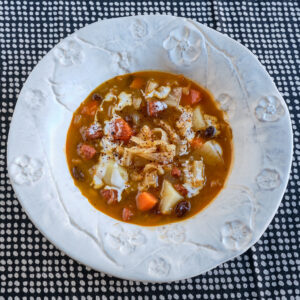
Sweet & Sour Cabbage Soup
Ingredients
- 2-4 tablespoons extra virgin olive oil or other neutral oil
- 2 cups Linguica sausage fully cooked, smoked pork sausages (Portuguese Linguica), skin removed and cut into 1/4-inch cubes
- 2 cups medium-large yellow onion peeled, cored, chopped (2 cups/12 ounces)
- 3 cloves minced garlic skinned, trimmed, minced
- —————————————————————
- 1 bay leaf
- ½ teaspoons crumbed dried rosemary
- ½ teaspoon dried crumbed oregano
- ½ teaspoons crumbed thyme
- ½ teaspoon dried crumbled sage
- —————————————————————-
- 2 large carrots trimmed, peeled, ½-inch dice
- 2 large celery ribs trimmed, ½-inch slice
- 3-4 large new potatoes peeled, ¾-inch dice
- 4 cups 8 ounces trimmed, shredded cabbage
- ½ cup raisins or currants
- —————————————————————-
- ½ cup organic cider vinegar
- ¼ cup packed brown sugar
- —————————————————————-
- 6 cups chicken or vegetable stock and more to taste
- —————————————————————-
- sea salt to taste
- freshly ground black pepper to taste
- —————————————————————-
- sour cream for serving
Instructions
- In a large sauté pan, heat olive oil and brown the sausage on all sides.
- Push sausage to the side, add additional olive oil if necessary, and add onion and garlic. Sauté until translucent but not browned.
- Push all ingredients to the side and add cabbage.
- Sauté for a couple of minutes and then combine with other ingredients.
- Add bay leaf, rosemary, oregano, thyme, and sage. Stir to combine.
- Add carrots, celery, potatoes, cabbage, and raisins.
- Toss and sauté for several minutes to combine.
- Push all vegetables to the side.
- Add cider vinegar and reduce by half.
- Add brown sugar and whisk to melt and smooth. Combine with other ingredients in pan.
- Add stock and bring to a simmer.
- Season to taste with salt and pepper.
- Serve piping hot, with or without a drizzle of sour cream.
- Makes 2-3 quarts. Serves 4-6.
Ingredients (listed by order of use)
- 2-4 tablespoons extra virgin olive oil (or other neutral oil)
- 2 10-inch, fully cooked, smoked pork sausages (Portuguese Linguica), skin removed and cut into 1/4-inch cubes
- 1 medium-large yellow onion, peeled, cored, chopped (2 cups/12 ounces)
- 3 large cloves garlic, skinned, trimmed, minced
- —————————————————————
- 1 bay leaf
- ½ teaspoons crumbed dried rosemary
- ½ teaspoon dried crumbed oregano
- ½ teaspoons crumbed thyme
- ½ teaspoon dried crumbled sage
- —————————————————————-
- 2 large carrots, trimmed, peeled, ½-inch dice
- 2 large celery ribs, trimmed, ½-inch slice
- 3-4 large new potatoes, peeled, ¾-inch dice
- 4 cups (8 ounces) trimmed, shredded cabbage
- ½ cup raisins or currants
- —————————————————————-
- ½ cup organic cider vinegar
- ¼ cup packed brown sugar
- —————————————————————-
- 6 cups chicken or vegetable stock (and more to taste)
- —————————————————————-
- sea salt to taste
- freshly ground black pepper, to taste
- —————————————————————-
- sour cream, for serving
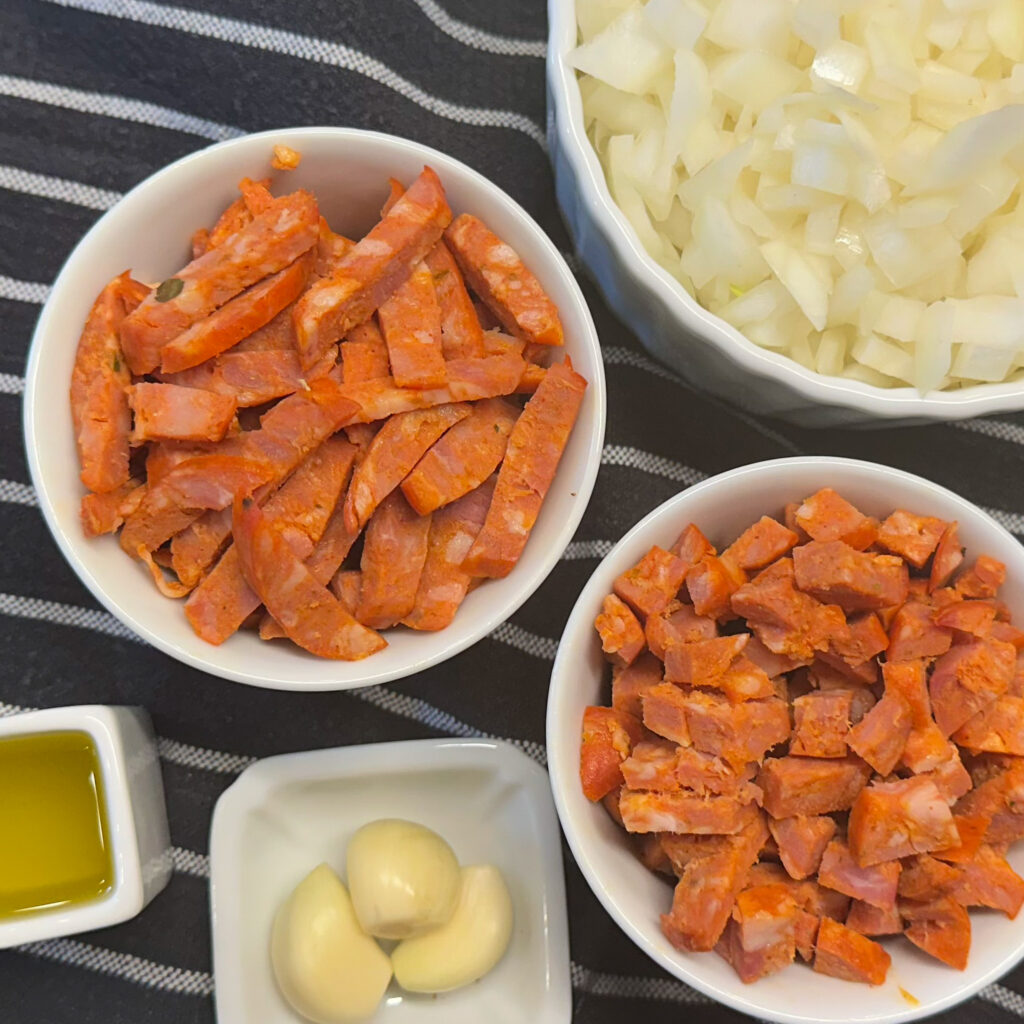
Step By Step
- In a large sauté pan, heat olive oil and brown the sausage on all sides.
- Push sausage to the side, add additional olive oil if necessary, and add onion and garlic. Sauté until translucent but not browned.
- Push all ingredients to the side and add cabbage.
- Sauté for a couple of minutes and then combine with other ingredients.
- Add bay leaf, rosemary, oregano, thyme, and sage. Stir to combine.
- Add carrots, celery, potatoes, cabbage, and raisins.
- Toss and sauté for several minutes to combine.
- Push all vegetables to the side.
- Add cider vinegar and reduce by half.
- Add brown sugar and whisk to melt and smooth. Combine with other ingredients in pan.
- Add stock and bring to a simmer.
- Season to taste with salt and pepper.
- Serve piping hot, with or without a drizzle of sour cream.
Makes 2-3 quarts. Serves 4-6.
Copyright Susan S. Bradley. All rights reserved.


